Emma Cocker and Clare Thornton
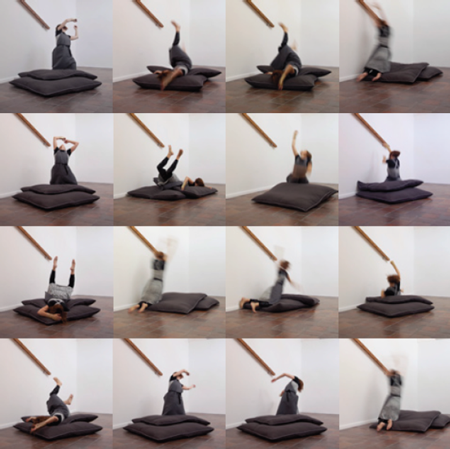
The Italic I is a practice-based collaboration between writer-artist Emma Cocker and interdisciplinary artist Clare Thornton, that explores the various states of potential made possible through purposefully surrendering to the event of a repeated fall. Within our artistic investigation, the act of falling is apprehended consciously as a training exercise for both mind and muscle, tested out in physical, cognitive, and even linguistic terms. Our inquiry comprises an attempt to capture and communicate the event of falling visually and linguistically, through the prism of performance, photography and the generation of a poetic lexicon. The studio or gallery is approached as a gymnasium within which to practice falling; however, the purpose of practicing is not towards a telos, the perfection of a given move or some future performance. Rather, falling is repeated in a move towards deeper understanding, for becoming more sensitized to the experience, more attuned to its risings and falls, its intensities and durations. In these terms, the athleticism inherent within the activity itself becomes a means for increasing one’s capacity (as it is practiced), for producing unexpected forms of embodied knowledge and augmented subjectivity.
Testing (the) Ground — setting up the conditions
There is always a before. It is never the first. Creating a scene, it will come when the conditions are conducive.
Opening Attempt — warming and flexing
Imagine carving a channel and then moving into it. Descending into it. Not just downward, dipping — maybe leaping too. The preparatory isn’t necessarily one of knowing what will unfold. There is a letting go before you can let go. Stretching — muscular, bodily. Pushing at the edges or the limits. This achieving and letting go — a reaching towards.
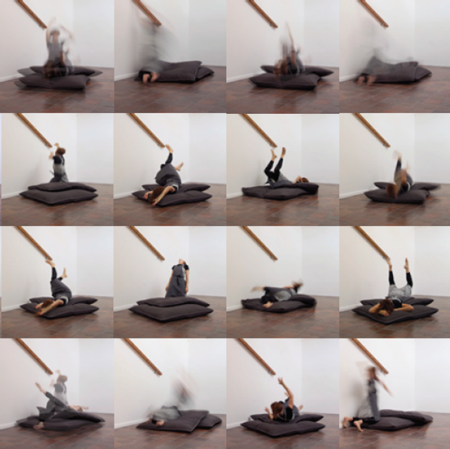
Entering the Arc — trust, twist, torque
Forging a different relationship. Coming into movement, with confidence. Close your eyes to the normal sequencing of the world, the normal speed of the world. There is a gap, but this is only temporary. Your eyes will be required again shortly. You will not be left behind. There is much work to do not to respond habitually. It will take a while to acclimatize. The studio can be a space for building this resilience. Forces and currents, bending of energy: receptive.
A Commitment Made — working against impulse
Purposefully engaged, not random, not some idle frippery. Mute, opaque, yet not secretive. Drive of the intuitive, to disobey the habit that would have us upright, to trip this tendency up. Renunciáre — put aside, hold back, resist. Bring to bear, to concentrate on: intensify in effort.
Voluntary Vertigo — ilinx, inclination
Head strong, head long. Edging or a leaning into — willfully, to deviate from the strictly horizontal or vertical. Predisposition. Disposition. An attitude. Étude. Incline — to dip or slope downward, to scoop. Tendency towards. Bent. Descent.

Becoming Diagonal — the italic i
Geometry helps. Finding the right angle. From infinite permutations between the horizontal and vertical, hair thin lines comprise the fiber of the curve. The distribution of force is not a representation of time as space. A vector of force, rising again — unexpected lift. The impression of exterior simplicity belies the interior complexity. Arguably, its sequential order is not consistent.
Touching Limits — tilt towards (the other)
The limit becomes a point of leverage, containing and controlling the tilt. To let go, repel, then to reach, a gesture towards a context. Involve — bring into intricate or complicated form. From involvere — entangle, implicate. To be bound up with something from which it is difficult to become extricated.
Embodiment/Disembodiment — mind body partition
The body makes phrases, exploratory gestures, bypassing the mind. Feeling its limitations, irritating blockages, wrestling with ways to articulate. Piecing things together. A whole set of mind and muscle activations, intermingling. Then bifurcation: division and splitting, intensity and extensity.
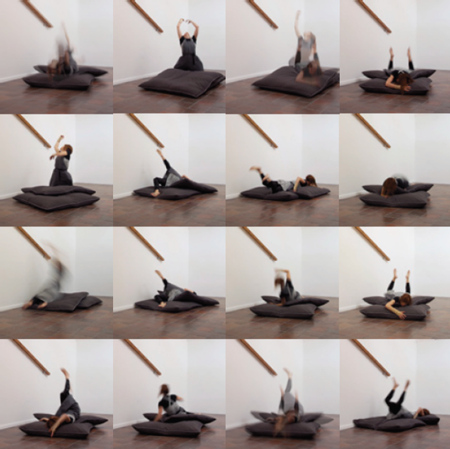
Formless — horizontality
Caught between states, working the edges to become less solid. Becoming liquid, now steam. No, now moist particle-filled air. This blur between the self and the world is like the smoke and the air. Renouncing solidity. Light, precise — the I dissolves. Fleeting submersion, a momentary loss of bearings.
Letting Go — a liquid state
Immersion (in the undercurrent): becoming fluid, liquescent. Release. Flow. Optimistic collapse. Not thinking of the edges, but still, stretching the meniscus. There is a moment where it holds shape beyond the limits of its containment. It is totally to do with the curvature of dynamic motion. It could break at any point.
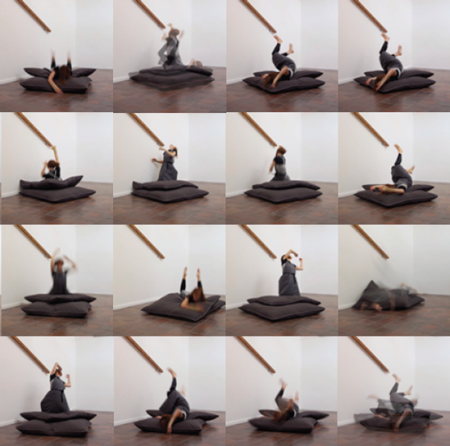
Ecstatic Impotency — the jouissance of impuissance
Losing language. But you still have to talk about desire … without veering off course. Not wayward. This is where restraint comes in — a refusal to be seduced. Restrained rapture. Measure. Exercise discipline to maintain the sense of tension. A momentary loss of concentration; energies dissipate through lack of focus. Turned upside down or overthrown, over the helm. Overwhelm. This is not an end in itself. It is not about getting carried away. Groundedness is required. So, be prepared to stem the flow. Tone it round. Caution against (over) elevation: the excessive I, the elevated I.
Folding of Attention — a heightened subjectivity
Not disorientation but a shift in orientation. Elemental transformation. Composition. Composure. Compose. Fall into an arrangement. Going inward. Turned backward. Inverted. Inversion — to turn or change. Turn inside out, to fold. To turn around on an axis. Revolve — from volvere, to roll or wind. Turn over, rolling on the tongue, the release of language from itself.
Gravity/Levity — striking the right balances
Hand striking the floor, marking time. Push and pull; lag or drag. Tempering — to calm, to modify its properties. Restraint has positive force, a necessary tension. Keeping form, one foot on the ground. Anchoring, maintaining the equilibrium. Retaining the lightness, bring to ground without weight.
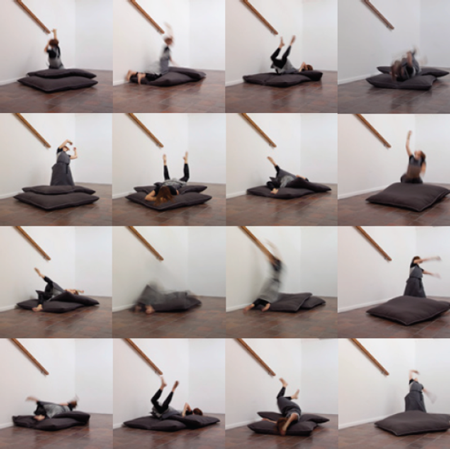
Breathless — ventilating the idea
Decompress. Distill. Cooling down but not towards resolution. Maybe it is useful to bring in fermata, the inverted arc … extended beyond normal duration. Beyond sustaining a note. Considered pause, return or realignment.
Voluptuous Recovery — return, yet charged
To bring to mind — to scan has haste and necessity, yet nothing about its swiftness is inaccurate. Rotational survey. To focus or centre upon, alert. Elasticity becomes extra-ordinary through exhaustion, a productive slackening. At that moment of relax and slack, extension: a hovering non-dispersal.
Recalibrate … Loop — desire to repeat
Revolve — to move in a circular or curving orbit, to keep the momentum. Recompose, with transformation. Reconfigure. Reassemble. Resolve — to bring more or less deeply into something. Steadfast, a recommitment is made. Temporary states, always having to be produced. Reset, retune — continuous present and a continual beginning again and again.
Within our investigation, we ask what it might mean to stay or persist with the experience of falling, to intensify its effort, its affect. In this sense, our studio-as-gymnasium is less akin to the contemporary ‘work-out’ culture, intent on shaping the body towards a particular target or goal. Rather, we approach the studio as a contemporary manifestation of the Ancient Greek gymnasium, a charged site for testing both mind and muscle, the convergence of athletics and rhetoric for exercising language as well as limbs. A body falls over and over, again and again; a lens acts as witness. Each movement begins before the movement has truly begun; every move is preceded in an endless falling loop. A commitment is made to the event of repeated falling in and of itself, to putting the diagonal under pressure.
This ‘thought experiment’ is a version of The Italic I, an artists’ publication produced by Emma Cocker and Clare Thornton. The Italic I is an ongoing collaboration also comprising sculptural, time-based and textual works for exhibition, animated by a series of live events, alongside performance readings and published writing.
The Italic I, Emma Cocker and Clare Thornton, 2014 (all images)
All images by and courtesy the artists.
Emma Cocker is a writer-artist and Reader in Fine Art at Nottingham Trent University. Operating under the title Not Yet There, her research often addresses the endeavour of creative labour, focusing on models of (art) practice and subjectivity that resist or refuse the pressure of a single or stable position by remaining willfully unresolved. Cocker’s recent writing has been published in Failure, 2010; Stillness in a Mobile World, 2010; Drawing a Hypothesis: Figures of Thought, 2011; Hyperdrawing: Beyond the Lines of Contemporary Art, 2012; On Not Knowing: How Artists Think, 2013, and Reading/Feeling, 2013. She has presented performance-lectures and video works internationally including at Flat Time House, London, M_HKA, Antwerp; NGBK, Berlin; Stadtpark Forum, Graz & AGORA: The 4th Athens Biennale. not-yet-there.blogspot.com
Clare Thornton is an interdisciplinary maker working with performance, sculpture, installation and print. She is an Associate Teacher at the University of Bristol Department of Drama, Film & TV. In 2007 she co- founded The Performance Re-enactment Society for investigating the problems and potential of performance and its documents, with projects shown at Arnolfini, Spike Island, Flattime House/South London Gallery and Gagosian Gallery NY. Thornton has shown her work extensively nationally and internationally (both as solo projects and collaborations) in Scandinavia, Latvia, Turkey, Australia, and the USA. Recent exhibition and bookwork projects include The Dandy and Mute, Oriel Myrddin, Carmarthen, Wales (2014); Corridors, Stairways & Corners, Arnolfini, Bristol (2013); A Lexicon of Labour Movements, KWMC with The Showroom Projects, Bristol, (2013.) clarethornton.com